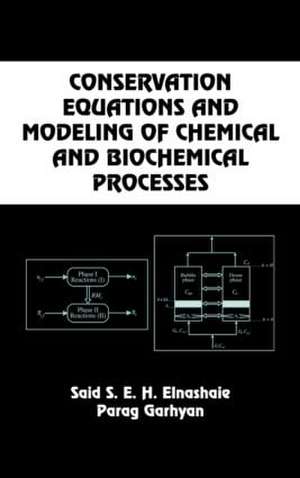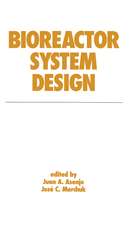Conservation Equations And Modeling Of Chemical And Biochemical Processes: Chemical Industries
Editat de Said S.E.H. Elnashaie, Parag Garhyanen Limba Engleză Hardback – 26 mar 2003
Din seria Chemical Industries
-
 Preț: 362.62 lei
Preț: 362.62 lei -
 Preț: 326.49 lei
Preț: 326.49 lei -
 Preț: 436.14 lei
Preț: 436.14 lei - 18%
 Preț: 1308.97 lei
Preț: 1308.97 lei -
 Preț: 436.14 lei
Preț: 436.14 lei - 15%
 Preț: 568.28 lei
Preț: 568.28 lei -
 Preț: 436.14 lei
Preț: 436.14 lei - 18%
 Preț: 2210.92 lei
Preț: 2210.92 lei - 13%
 Preț: 321.56 lei
Preț: 321.56 lei - 15%
 Preț: 489.26 lei
Preț: 489.26 lei - 18%
 Preț: 1027.65 lei
Preț: 1027.65 lei -
 Preț: 475.78 lei
Preț: 475.78 lei -
 Preț: 446.60 lei
Preț: 446.60 lei - 26%
 Preț: 445.15 lei
Preț: 445.15 lei -
 Preț: 436.14 lei
Preț: 436.14 lei -
 Preț: 436.14 lei
Preț: 436.14 lei - 26%
 Preț: 1693.35 lei
Preț: 1693.35 lei - 9%
 Preț: 674.29 lei
Preț: 674.29 lei - 18%
 Preț: 2209.35 lei
Preț: 2209.35 lei - 18%
 Preț: 2236.19 lei
Preț: 2236.19 lei - 25%
 Preț: 879.89 lei
Preț: 879.89 lei - 15%
 Preț: 461.03 lei
Preț: 461.03 lei - 15%
 Preț: 461.03 lei
Preț: 461.03 lei - 22%
 Preț: 352.95 lei
Preț: 352.95 lei - 15%
 Preț: 540.06 lei
Preț: 540.06 lei -
 Preț: 436.14 lei
Preț: 436.14 lei -
 Preț: 436.14 lei
Preț: 436.14 lei - 28%
 Preț: 1413.77 lei
Preț: 1413.77 lei -
 Preț: 436.14 lei
Preț: 436.14 lei - 26%
 Preț: 1015.04 lei
Preț: 1015.04 lei -
 Preț: 436.14 lei
Preț: 436.14 lei -
 Preț: 436.14 lei
Preț: 436.14 lei - 30%
 Preț: 780.53 lei
Preț: 780.53 lei - 15%
 Preț: 461.03 lei
Preț: 461.03 lei - 18%
 Preț: 1546.39 lei
Preț: 1546.39 lei - 18%
 Preț: 1043.94 lei
Preț: 1043.94 lei - 18%
 Preț: 1799.16 lei
Preț: 1799.16 lei - 18%
 Preț: 2062.15 lei
Preț: 2062.15 lei - 30%
 Preț: 1869.17 lei
Preț: 1869.17 lei - 15%
 Preț: 461.03 lei
Preț: 461.03 lei
Preț: 587.91 lei
Preț vechi: 691.66 lei
-15% Nou
Puncte Express: 882
Preț estimativ în valută:
112.50€ • 117.75$ • 93.63£
112.50€ • 117.75$ • 93.63£
Carte tipărită la comandă
Livrare economică 31 martie-14 aprilie
Preluare comenzi: 021 569.72.76
Specificații
ISBN-13: 9780824709570
ISBN-10: 0824709578
Pagini: 668
Ilustrații: illustrations, index
Dimensiuni: 156 x 234 x 35 mm
Greutate: 1 kg
Ediția:1
Editura: CRC Press
Colecția CRC Press
Seria Chemical Industries
Locul publicării:Boca Raton, United States
ISBN-10: 0824709578
Pagini: 668
Ilustrații: illustrations, index
Dimensiuni: 156 x 234 x 35 mm
Greutate: 1 kg
Ediția:1
Editura: CRC Press
Colecția CRC Press
Seria Chemical Industries
Locul publicării:Boca Raton, United States
Public țintă
ProfessionalCuprins
Preface 1 System Theory and Chemical/Biochemical Engineering Systems 1. 1 System Theory 1.2 Steady State, Unsteady State, and Thermodynamic Equilibrium 1.3 Modeling of Systems 1.4 Fundamental Laws Governing the Processes in Terms of the State Variables 1.5 Different Classifications of Physical Models 1.6 The Story of Chemical Engineering in Relation to System Theory and Mathematical Modeling 1.7 The Present Status of Chemical Industry and Undergraduate Chemical Engineering Education 1.8 System Theory and the Mathematical Modeling Approach Used in This Book 1.9 Modeling and Simulation in Chemical Engineering 1.10 Amundson Report and the Need for Modem Chemical Engineering Education 1.11 System Theory and Mathematical Modeling as Tools for More Efficient Undergraduate Chemical Engineering Education 1.12 Summary of the Main Topics in this Chapter 2 Material and Energy Balances 2.1 Material and Energy Balances 2.2 Single and Multiple Reactions: Conversion, Yield, and Selectivity 2.3 Generalized Material Balance 2.4 Solved Problems for Mass Balance 2.5 Heat Effects 2.6 Overall Heat Balance with Single and Multiple Chemical Reactions 2.7 Solved Problems for Energy Balance 3 Mathematical Modeling (l): Homogeneous Lumped Systems 3. 1 Mathematical Modeling of Homogenea us Lumped Processes 3.2 Mathematical Model Building: General Concepts 3.3 Generic and Customized Models 3.4 Economic Benefits of Using High-Fidelity Customized Models 3.5 Jncorporation of Rigorous Models into Flowsheet Simulators and Putting Mathematical Models into User-Friendly Software Packages 3.6 From Material and Energy Balances to Steady-State Design Equations (Steady-State Mathematica1 Models) 3.7 Simple Examples for the General Equations 3.8 Modeling of Biochemical Systems 4 Mathematical Modeljng (ll): Homogeneous Distributed Systems and Upsteady-State Behavior 4.1 Modeling of Distributed Systems 4.2 The Unsteady-State Terms in Homogeneaus and Heterogeneaus Systems 4.3 The Axial Dispersion Model 5 Process Dynamics and Control 5.1 Various Forms of Process Dynamic Models 5.2 Formulation of Process Dynamic Models 5.3 State-Space and Transfer Domain Models 5.4 Introductory Process Control Concepts 5.5 Process Dynamics and Mathematical Tools 5.6 The Laplace Transformation 5.7 Characteristics of Idea l Forcing Functions 5.8 Basic Principles of Bloc k Diagrams, Control Loops, and Types of Classica l Control 5.9 Linearization 5.10 Second-Order Systems 5. 12 Block Diagram Algebra 5. 13 Some Techniques for Choosing the Controller Settings 6 Heterogeneous SyStems 6. 1 Material Balance for Heterogeneaus Systems 6.2 Design Equations (Steady-State Models) for lsothermal, Heterogeneaus Lumped Systems 6.3 Design Equations (Steady-State Models) for Isothermal Distributed Heterogeneaus Systems 6.4 Nonisothermal Heterogeneaus Systems 6.5 Examples of Heterogeneaus Systems 7 Practical Relevance of Bifurcation, Instability, and Chaos in Chemical and Biochemical Systems 8 Novel Designs for Iudustrial Chemicai/Biocbemical Systems
Notă biografică
Said S. E. H. Elnashaicz, Parag Garhyan both Auburn University, Auburn, Alabama, U.S.A.
Descriere
Presenting strategies in control policies, this text uses a systems theory approach to predict, simulate and streamline plant operation, conserve fuel and resources, and increase workplace safety in the manufacturing, chemical, petrochemical, petroleum, biochemical and energy industries



